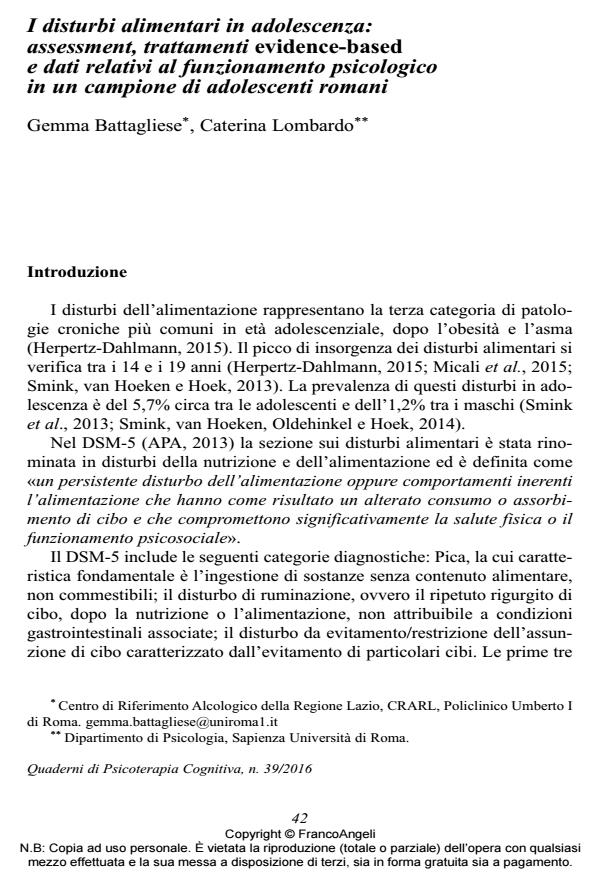I disturbi alimentari in adolescenza: assessment, trattamenti evidence-based e dati relativi al funzionamento psicologico in un campione di adolescenti romani
Titolo Rivista QUADERNI DI PSICOTERAPIA COGNITIVA
Autori/Curatori Gemma Battagliese, Caterina Lombardo
Anno di pubblicazione 2016 Fascicolo 2016/39
Lingua Italiano Numero pagine 27 P. 42-68 Dimensione file 174 KB
DOI 10.3280/QPC2016-039004
Il DOI è il codice a barre della proprietà intellettuale: per saperne di più
clicca qui
Qui sotto puoi vedere in anteprima la prima pagina di questo articolo.
Se questo articolo ti interessa, lo puoi acquistare (e scaricare in formato pdf) seguendo le facili indicazioni per acquistare il download credit. Acquista Download Credits per scaricare questo Articolo in formato PDF

FrancoAngeli è membro della Publishers International Linking Association, Inc (PILA)associazione indipendente e non profit per facilitare (attraverso i servizi tecnologici implementati da CrossRef.org) l’accesso degli studiosi ai contenuti digitali nelle pubblicazioni professionali e scientifiche
I disturbi alimentari rappresentano uno dei disturbi piu seri in adolescenza a causa del loro decorso cronico e delle gravi conseguenze mediche e psichiatriche ad essi associate. Tra i trattamenti evidence-based indicati per i disturbi alimentari troviamo il Family-Based Treatment, indicato come trattamento di prima scelta per l’anoressia, l’Adolescent-Focused Therapy e la CBT-E che permette di lavorare sugli aspetti del funzionamento psicologico che possono ostacolare il trattamento, quali perfezionismo, bassa autostima e difficolta interpersonali. Gli obiettivi del presente lavoro sono: fornire una panoramica sugli aspetti di diagnosi, valutazione, eziologia e trattamento dei disturbi alimentari in adolescenza e portare un contributo empirico circa la presenza di comportamenti alimentari disfunzionali in un campione di adolescenti italiani romani di eta compresa fra 14 e 19 anni. I risultati dello studio dimostrano che il 4% (6,4% femmine; 1% maschi) degli adolescenti esaminati riferisce sintomi di disturbi alimentari clinicamente rilevanti Relativamente alle caratteristiche psicologiche associate, gli adolescenti che riportano una maggiore intensita sintomatologica riportano anche una piu bassa autostima, maggiori problemi personali e interpersonali, una maggiore disregolazione emotiva, maggiore percezione di inadeguatezza, e disadattamento psicologico generale. Inoltre, nelle femmine una maggiore intensita dei sintomi si associa ad alti livelli di perfezionismo e ipercontrollo. E importante, quindi, che i clinici che si confrontano con questo spettro di disturbi in eta adolescenziale conducano un’adeguata valutazione, intervenendo con trattamenti basati sulle evidenze che tengano conto anche delle caratteristiche di funzionamento psicologico associate al disturbo.
Parole chiave:Anoressia nervosa, bulimia nervosa, Binge Eating Disorder, adolescenza, trattamenti evidence-based.
Gemma Battagliese, Caterina Lombardo, I disturbi alimentari in adolescenza: assessment, trattamenti evidence-based e dati relativi al funzionamento psicologico in un campione di adolescenti romani in "QUADERNI DI PSICOTERAPIA COGNITIVA" 39/2016, pp 42-68, DOI: 10.3280/QPC2016-039004